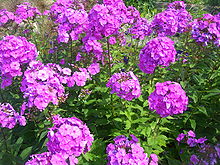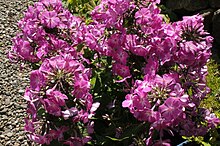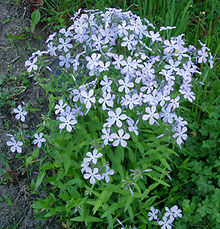Phlox
| Phlox | |
|---|---|

| |
| Phlox paniculata(garden phlox) | |
| Scientific classification | |
| Kingdom: | Plantae |
| Clade: | Tracheophytes |
| Clade: | Angiosperms |
| Clade: | Eudicots |
| Clade: | Asterids |
| Order: | Ericales |
| Family: | Polemoniaceae |
| Genus: | Phlox L.(1753) |
| Species[1] | |
|
68; see text | |
| Synonyms[1] | |
| |
Phlox(/ˈflɒks/;Ancient Greek:φλόξ"flame"; plural "phlox" or "phloxes",Ancient Greek:φλόγεςphlóges) is a genus of 68 species ofperennialandannualplants in the familyPolemoniaceae.They are found mostly in North America (one inSiberia) in diverse habitats fromalpine tundrato openwoodlandandprairie.Some flower in spring, others in summer and fall. Flowers may be pale blue, violet, pink, bright red, or white. Many arefragrant.
Description
[edit]
The name is derived from the Ancient Greek wordphloxmeaning flame in reference to the intense flower colors of some varieties.[2]Fertilized flowers typically produce one relatively largeseed.The fruit is a longitudinallydehiscentcapsulewith three or morevalvesthat sometimes separate explosively.[3]
Some species such asP. paniculata(garden phlox) grow upright, while others such asP. subulata(moss phlox, moss pink, mountain phlox) grow short and matlike. Paniculata or tall phlox, is a native American wildflower that is native from New York to Iowa south to Georgia, Mississippi and Arkansas. It blooms from July to September.
Creeping phlox spreads rapidly and makes great ground cover.[4]It can be planted to cover banks, fill spaces under tall trees, and spill and trail over slopes. Creeping phlox blooms in spring and produces long, spreading stems, which become woody with age. It was introduced into cultivation by the late 1700s.[5]
The foliage ofPhloxis a food for thelarvaeof someLepidopteraspecies includingdot moth,Gazoryctra wielgusi,hummingbird hawk-mothandSchinia indiana(which feeds exclusively onP. pilosa). Phlox species are also a popular food source forgroundhogs,rabbitsanddeer.
Species
[edit]

The species in the genus include:[1]
- Phlox aculeataA.Nelson
- Phlox adsurgensTorr. ex A.Gray
- Phlox albomarginataM.E.Jones
- Phlox alyssifoliaGreene
- Phlox amabilisBrand
- Phlox amoenaSims
- Phlox amplifoliaBritton
- Phlox andicola(Britton) E.E.Nelson
- Phlox austromontanaCoville
- Phlox bifidaL.C.Beck
- Phlox buckleyiWherry
- Phlox caespitosaNutt.
- Phlox carolinaL.
- Phlox caryophyllaWherry
- Phlox cluteanaA.Nelson
- Phlox colubrinaWherry & Constance
- Phlox condensata(A.Gray) E.E.Nelson
- Phlox cuspidataScheele
- Phlox diffusaBenth.
- Phlox dispersaSharsm.
- Phlox divaricataL.
- Phlox dolichanthaA.Gray
- Phlox douglasiiHook.
- Phlox drummondiiHook.
- Phlox floridanaBenth.
- Phlox glaberrimaL.
- Phlox glabriflora(Brand) Whitehouse
- Phlox gladiformis(M.E.Jones) E.E.Nelson
- Phlox × glutinosaBuckley
- Phlox griseolaWherry
- Phlox hendersonii(E.E.Nelson) Cronquist
- Phlox hirsutaE.E.Nelson
- Phlox hoodiiRichardson
- Phlox idahonisWherry
- Phlox kelseyiBritton
- Phlox longifoliaNutt.
- Phlox maculataL.
- Phlox mesoleucaGreene
- Phlox mexicanaWherry
- Phlox missoulensisWherry
- Phlox mollisWherry
- Phlox multifloraA.Nelson
- Phlox nanaNutt.
- Phlox nivalisG.Lodd. ex Sweet
- Phlox oklahomensisWherry
- Phlox opalensisDorn
- Phlox ovataL.
- Phlox paniculataL.
- Phlox pattersoniiPrather
- Phlox peckiiWherry
- Phlox pilosaL.
- Phlox pulchra(Wherry) Wherry
- Phlox pulvinata(Wherry) Cronquist
- Phlox pungensDorn
- Phlox × pyramidalisSm.
- Phlox richardsoniiHook.
- Phlox rigidaBenth.
- Phlox roemerianaScheele
- Phlox sibiricaL.
- Phlox solivagaMayfield & Darrach
- Phlox speciosaPursh
- Phlox stoloniferaSims
- Phlox subulataL.
- Phlox tenuifoliaE.E.Nelson
- Phlox triovulataThurb. ex Torr.
- Phlox variabilisBrand
- Phlox vermejoensisB.S.Legler
- Phlox viridisE.E.Nelson
- Phlox viscidaE.E.Nelson
- Phlox woodhousei(A.Gray) E.E.Nelson
Cultivation
[edit]
Several species andcultivarsof phlox are commonly grown in gardens. Most cultivated phlox, with the notable exception ofPhlox drummondii,are perennial. Species from alpine habitats (and cultivars derived from them) require full sun and good drainage. Those from woodland habitats (such asPhlox divaricata) require partial shade and soil rich in humus. Those from waterside habitats (such asP. paniculata) require full sun and moisture at the roots.[6]Phlox are valued in the garden for their ability to attract butterflies. Phlox can bepropagatedfromstem cuttings.
References
[edit]- ^abc"PhloxL. "Plants of the World Online.Royal Botanic Gardens, Kew.Retrieved19 April2024.
- ^"Phlox paniculata", Missouri Botanical Garden
- ^Klaus Kubitzki (2004).Flowering plants, Dicotyledons: Celastrales, Oxalidales, Rosales, Cornales, Ericales.Springer. p. 311.ISBN9783540065128.
- ^"Growing Phlox",The Farmer's Almanac
- ^"Creeping Phlox",Thomas Jefferson Encyclopedia
- ^Prof. Craigmyle, M.,The Illustrated Encyclopedia of Perennials,Salamander Books Ltd, 2002, p222ISBN1 901683 78 8
Further reading
[edit]- Lady Bird Johnson Wildflower Center, University of Texas, Austin
- Natural Resources Conservation Service USDA
External links
[edit]![]() Media related toPhloxat Wikimedia Commons
Media related toPhloxat Wikimedia Commons
- Dole, Claire H. (2000)."Phlox: A Butterfly and Moth Magnet".Retrieved2007-05-08.
- Chisholm, Hugh,ed. (1911)..Encyclopædia Britannica.Vol. 21 (11th ed.). Cambridge University Press. p. 447.
